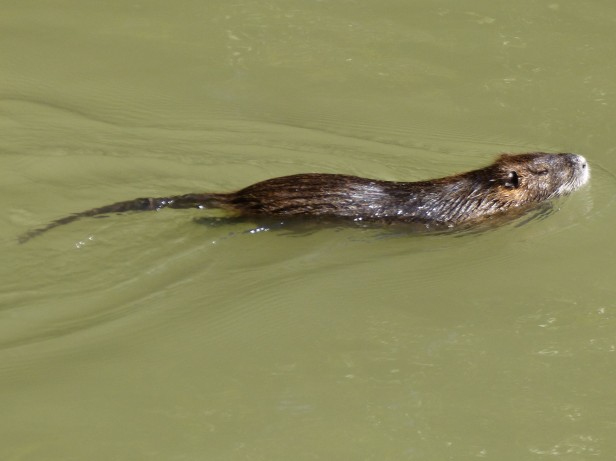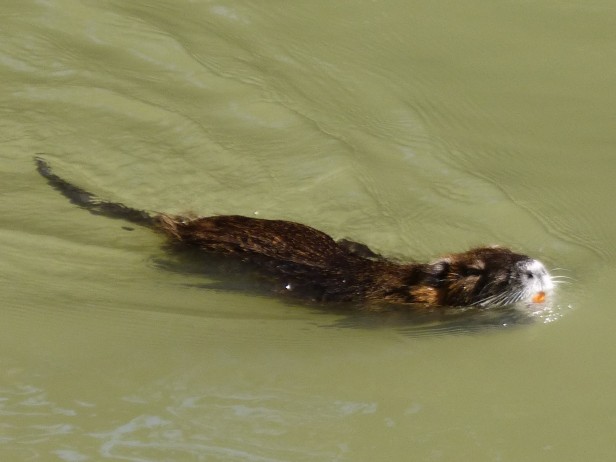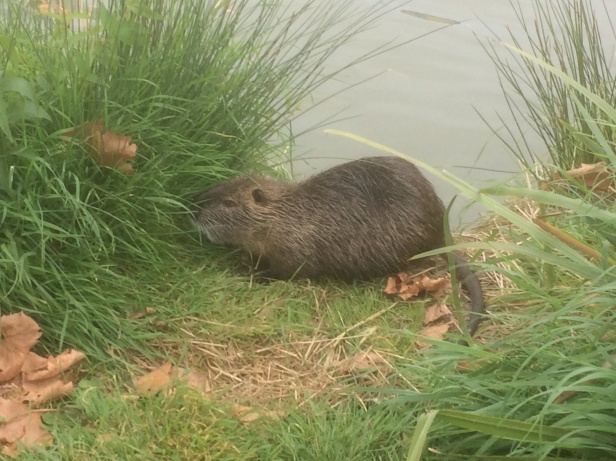

Is it an otter, a beaver, a giant rat or something else?
Well done, if you said ‘coypu’ or ‘ragondin’!
Neither of these possibilities were actually on my radar until I saw them swimming in the Canal du Midi. I thought they looked quite cute. However, further research would suggest that for many people this is not the case.
Coypu are native to South America and were originally introduced to France and the UK for their fur. They have webbed rear feet and orange coloured front teeth.
They are semi aquatic rodents who feast on vegetation and burrow into river banks. Both these actions can cause serious damage to the environment. They also carry leptospirosis. These are just some of the reasons they are viewed as pests.
There are a variety of ways in which these animals can be culled but I won’t go into the various methods in this post.
I have never seen it on any menus but my research came across several possible recipes for ragondin. These included pâté and stew… Not sure myself.

This is a photo of a local coypu I took recently. This coypu was alongside the Canal du Midi towpath and very close to the port in Castelnaudary. He – or she – didn’t seem at all perturbed by the passerbys on foot or boat.
Have you seen a ragondin/coypu? What do you think about them: a pest or cute? I’d love to know.
Discover more from Fancying France
Subscribe to get the latest posts sent to your email.


I didn’t even know of their existence, never mind having seen one. I do occasionally see the odd eat at the local pond when I take the grandchildren to see the ducks. Can’t say rodents have ever appealed as pets. Give me a cat or a dog anytime. A Rabbit would do too!
LikeLiked by 1 person
I said coypu, but knowing that they were native to South America didn’t expect them to be found in France. Like you I’m not sure if I’d fancy one served up on a plate. Btw I see you managed to leave a comment on my blog, well done for sorting the problem.
LikeLiked by 1 person
Thanks, Fiona, for letting me know that I have managed to comment on your blog. It took me a while but I got there in the end!
LikeLike
We have a lot of ragodin in Normandy and to be honest they are a pest, as you say, destroying river banks … my dog hates them and will go hunting them if given half a chance! Fully grown they are surprisingly big as I found out when cycling home one night and one thundered across the path in front of me. The ground shuddered under its heavy footsteps. I had also heard they were tasty to eat but having seen their teeth, like you I think I will give them a miss on the menu.
Thank you for adding this post to #AnimalTales – I am not sure if we have ever had coypu joining in before!
LikeLiked by 1 person
Haha! Glad to know it’s the first coypu post.
LikeLike
We have coypu in the pond up the road and I love to see them but know they are a pest. I love the pinemartins too but not in my loft!
LikeLiked by 1 person
Wow! I’ve never seen a pine marten but I’d like to. We have red squirrels which are so much cuter than the greys.
LikeLike
I’ve seen a bunch of these in the river at our local park and am scared of them. There’s one that is bigger than my dog and seems very aggressive. Even scarier that they carry lepto. Good thing we have a vet appointment this weekend for my dog’s yearly vaccines. #animaltales
LikeLiked by 1 person
Your local coypu sound most unpleasant! I don’t like the idea of one bigger than your dog. I’ve seen pictures of him on your blog. The aggressiveness sound scary, too. Yes, it is so important to have dogs vaccinated. Thanks for commenting.#AnimalTales
LikeLike
Thanks to watching a lot of Sir David Attenborough and also Octonauts, the UK kids programme, I did actually know what it was!! 🙂 Lovely pics! #animaltales
LikeLiked by 1 person
I’m impressed! Good old Sir David! Thank you so much for commenting #AnimalTales
LikeLike
I remember seeing Coypu in the river near Chartres in 2010 or 2011. We were baffled and amazed. It’s odd when non-native species thrive. Great post and great pics #AnimalTales
LikeLiked by 1 person
Thanks for commenting. It’s been very interesting to read the different reactions to coypu. I’m now off to have a look at your blog! #AnimalTales
LikeLike
I saw one yesterday at Castelnaudery, it was swimming and then crawled out on the steps of the canal to eat some vegetable scraps that I would say someone left there for it. I came quite close to take a photo and it didn’t seem afraid. Have never seen one before and a local told me what it was.
LikeLike
Yes. there are lots of them, in the Canal, at Castelnaudary. That’s where I took my photos! Thanks for commenting.
LikeLike
Under the name of nutria, these animals are terrible pests in Oregon, USA. They favor creeksides, but will come into suburbs, overturn garbage cans looking for food & even go after cats & small dogs as food!!
Someone in the 19th century introduced them as replacements for beaver fur.
LikeLiked by 1 person
Oh! I had no idea that they would eat small dogs and cats. Thanks for commenting.
LikeLike
Here in Frankfurt they are also called nutria. They live in a small river called the Nidda (a tributary of the Main). They aren’t afraid of people, in fact they often come up to people and beg for food.
LikeLiked by 1 person
I have heard the term ‘nutria’ before but not so often. They sound very tame in Frankfurt. I think it’s interesting how people have such varied opinions about these animals. Thanks for commenting!
LikeLiked by 1 person
We saw one walking past our house in rural Brittany, which was a bit of a surprise, as we are quite high up and a long way from any waterways or canals, only small ponds nearby.
LikeLiked by 1 person
I think I would have been surprised, too! I’ve only seen them in or by the canal. Thanks for commenting!
LikeLike
We just saw some of these in France on the river Seine
We thought it was a beaver, unfortunately not but still nice to see, despite them being a pest
LikeLiked by 1 person
Hi Wendy. Thanks for taking the time to comment. They are very beaver like and I must admit I also like seeing them, even if they are considered as pests. I guess it’s a bit like foxes in the UK.
LikeLike
I think he’s cute too!
LikeLiked by 1 person
😊
LikeLike
I saw lots of these on the bayous in Louisiana and shuddered each time one looked at me. They really scared me, and they were very big there, ‘rats on steroids’ I think I described them. As for eating them, definitely ‘no’!
LikeLiked by 1 person
When I first saw them, I thought the ragondins looked slightly like beavers, but now I’m not so sure! Some of the comments on this blog post have been quite off-putting! I don’t like the idea of rats on steroids! Here, on the Canal du Midi, they are often fed from the holiday boats.
LikeLike
morning everyone I saw in today in the pond where I run with my huskies. I let my one husky run free one day (bad idea) and Shadow ended up fighting with a large adult( possibly defending young) to say Shadow came off worse is an understatement, he had tears to his jaw lips and was bleeding profusely, I managed to get him away from the ragondin and I am pleased to say he recovered from his ordeal fully. Unfortunately he stills goes looking whenever we are around rivers or pounds, only now he is always on the harness and lead.
great posts and very informative thank you all.
Allan
Beaujolais.
LikeLiked by 1 person
What a horrible thing to happen! Your poor dog! I’m so pleased that he has recovered from his injuries. I’ve never met a ragondin when I’ve been with my dog and, having read your comment, I hope I never do. Perhaps the ragondin was defending its young, but that doesn’t lessen the horror of the experience. Thank you for taking the time to comment and I have to say that I love Huskies.
LikeLike
I saw many of them in the waters around New Orleans and, in fact, in an article I wrote about the Bayous I called them giant rats on steroids! I didn’t like them then and I still don’t like them. I certainly wouldn’t care to eat one but everyone to their own culinary tastes. I did once try ‘black rat’ which I was assured was superior to other rats, in Northern Thailand, only because we were eating with a Thai family who had ordered it and I felt I had to at least attempt to swallow one mouthful. I just about managed it. Nowadays I am armed with more excuses when faced with food that appals me.
LikeLiked by 1 person
‘Giant rats on steroids’ is a brilliant – if slightly terrifying description – of these animals! I’m impressed that you managed to eat one mouthful of ‘black rat’. I like to think I would do the same if I didn’t want to offend. Thanks for your interesting comment, Mari.
LikeLike